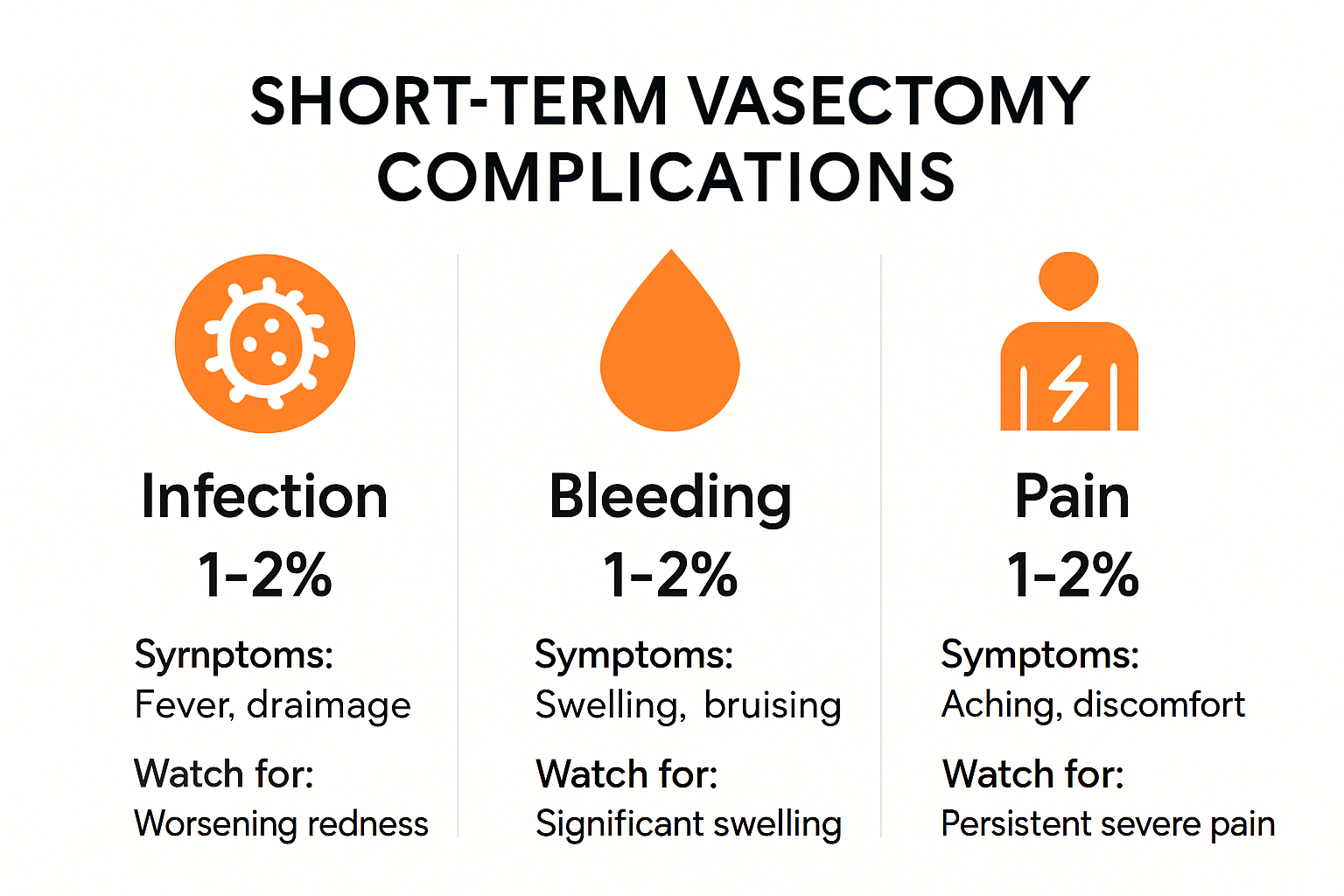Vasectomy might sound like a straightforward way to prevent pregnancy permanently, but the details get a lot more interesting when you dig deeper. Even though it’s one of the safest surgical procedures men can choose, about 1 to 2 percent will still experience infection, chronic pain, or other complications. Here’s the curveball. Most men worry about losing sexual function or hormonal changes, yet the data shows these fears rarely come true. The real risks are often less dramatic but matter much more than people realize.
Table of Contents
- Common Short-Term Vasectomy Complications Risk
- Long-Term Effects And Fertility Concerns
- How To Reduce Complications After Vasectomy
- When To Seek Medical Help For Complications
Quick Summary
| Takeaway | Explanation |
|---|---|
| Manage Postoperative Pain | Most men experience some pain and swelling after a vasectomy, which usually resolves within a week. Over-the-counter medications and supportive underwear can help alleviate discomfort. |
| Monitor for Complications | Be vigilant for signs of infection, excessive bleeding, or severe pain after surgery, as these symptoms require immediate medical attention. Symptoms include high fever, severe pain, or unusual discharge. |
| Understand Long-Term Effects | A vasectomy does not typically affect hormone levels or sexual function, but chronic pain and psychological issues can occur. Discussing long-term effects with a healthcare provider is crucial for informed decision-making. |
| Prepare for the Procedure | Proper preoperative planning, including health screenings and discussions with your urologist, can minimize complications. Arrange for post-procedure support for recovery. |
| Seek Help for Symptoms | If experiencing prolonged pain, anxiety, or unusual hormonal changes post-vasectomy, contact your healthcare provider. Documenting symptoms can assist in effective treatment. |
Common Short-Term Vasectomy Complications Risk

Understanding the potential short-term complications of a vasectomy helps men prepare and respond effectively to postoperative changes. While vasectomy is generally a safe and minimally invasive procedure, knowing the vasectomy complications risk can help patients manage expectations and recognize when professional medical attention might be necessary.
Immediate Postoperative Pain and Discomfort
Most men experience some level of pain and discomfort following the vasectomy procedure. This is a normal part of the healing process and typically resolves within a few days to a week. The pain can range from mild soreness to more intense sensations around the surgical site. Potential pain characteristics include:
- Localized aching: Sharp or dull pain in the scrotum and surrounding area
- Swelling: Minor inflammation that may cause temporary discomfort
- Sensitivity: Increased tenderness when moving or touching the surgical area
Physicians often recommend over-the-counter pain medications, cold compresses, and wearing supportive underwear to manage these symptoms. Learn more about your post-vasectomy recovery timeline to understand what to expect during the initial healing period.
Infection and Bleeding Risks
Infection and bleeding represent two critical short-term vasectomy complications that require careful monitoring. While rare, these risks can occur and demand immediate medical attention. Key infection indicators include:
- Fever above 100.4°F
- Excessive redness or warmth around the surgical site
- Unusual discharge or pus
- Significant swelling that increases over time
Bleeding complications might manifest as:
- Persistent bleeding from the surgical incision
- Large bruises or hematomas
- Significant scrotal swelling
Research from the American Urological Association suggests that infection rates for vasectomies are relatively low, approximately 1-2% of procedures. However, patients should remain vigilant and contact their healthcare provider if they experience concerning symptoms.
Potential Psychological and Sexual Complications
Beyond physical risks, men might encounter short-term psychological and sexual complications following a vasectomy. These can include temporary anxiety, concerns about sexual performance, or mild mood changes. Some men report:
- Temporary reduction in sexual desire
- Psychological adjustment to the procedure
- Mild performance anxiety
Most of these psychological responses are transient and resolve as men become more comfortable with their decision. Understanding vasectomy success rates can help alleviate some of these concerns by providing clear, factual information about the procedure’s effectiveness.
It is crucial to remember that while these complications exist, they are generally manageable and occur in a small percentage of cases. Open communication with your healthcare provider, following postoperative instructions, and maintaining good personal hygiene can significantly reduce your vasectomy complications risk.
Long-Term Effects and Fertility Concerns
While vasectomies are considered a highly effective form of permanent birth control, understanding the long-term effects and potential fertility concerns is crucial for men considering this procedure. The decision to undergo a vasectomy involves careful consideration of both immediate and future reproductive health implications.
Hormonal and Reproductive System Impact
Contrary to common misconceptions, a vasectomy does not fundamentally alter a man’s hormonal balance or sexual function. The procedure only interrupts sperm transportation, leaving testosterone production and sexual performance largely unchanged. Research from the Mayo Clinic confirms that men continue to produce testosterone and experience normal sexual desire and function after the procedure.
However, some men may experience subtle changes in their reproductive system. The body continues to produce sperm, but these sperm are reabsorbed rather than being ejaculated. This natural process does not typically cause any significant health concerns. Verify your vasectomy results with accurate laboratory testing to ensure complete reproductive effectiveness.

Potential Long-Term Complications
While rare, some men might experience long-term complications following a vasectomy. These can include:
- Chronic Pain Syndrome: A small percentage of men may develop persistent testicular pain
- Granuloma Formation: Small lumps that can develop at the surgical site
- Psychological Impact: Long-term emotional responses to the permanent fertility change
A comprehensive study published in the Journal of Urology indicates that chronic pain affects approximately 1-2% of men who undergo vasectomy. Most men adapt well to the procedure, with minimal long-term negative effects on overall health and sexual function.
Fertility Reversal and Alternative Options
Men who may want children in the future should carefully consider the permanence of a vasectomy. While vasectomy reversal is possible, it is not always successful and can be expensive. Microsurgical reversal techniques have improved over time, with success rates varying between 30-90% depending on factors such as:
- Time elapsed since the original vasectomy
- Surgical technique used
- Individual reproductive health
- Presence of any additional fertility issues
For those uncertain about permanent fertility loss, alternatives exist. Some men choose sperm banking before the procedure as a precautionary measure. This allows for potential future biological children through assisted reproductive technologies.
It is essential to have comprehensive discussions with a healthcare provider about long-term fertility concerns. A thorough understanding of potential risks, combined with personal medical history and future family planning goals, will help men make informed decisions about vasectomy.
Ultimately, while vasectomy complications risks exist, they remain relatively low. Most men experience no significant long-term effects and report high satisfaction with their decision. Ongoing medical advancements continue to make vasectomy an increasingly safe and reliable method of permanent contraception.
How to Reduce Complications After Vasectomy
Reducing vasectomy complications risk requires a proactive and informed approach. By understanding and implementing strategic measures before, during, and after the procedure, men can significantly minimize potential health challenges and ensure a smoother recovery process.
Preoperative Preparation and Planning
Successful vasectomy outcomes begin with thorough preoperative preparation. Medical professionals recommend several critical steps to minimize potential complications:
- Complete comprehensive health screening: Ensure no underlying conditions might increase surgical risks
- Discuss medical history thoroughly: Share all relevant health information with your urologist
- Stop blood-thinning medications: Consult your doctor about temporarily discontinuing aspirin or anticoagulants
- Arrange post-procedure support: Plan for transportation and initial recovery assistance
Learn about your complete post-vasectomy recovery timeline to understand comprehensive preparation strategies. Research from the American Urological Association emphasizes that patients who thoroughly prepare experience fewer postoperative complications.
Immediate Postoperative Care Strategies
The first week following a vasectomy is crucial for minimizing complications and promoting optimal healing. Critical care strategies include:
- Rest and limited physical activity: Avoid strenuous exercises and heavy lifting
- Proper wound management: Keep the surgical site clean and dry
- Use supportive underwear: Wear tight-fitting athletic supporters to minimize scrotal movement
- Apply cold compresses: Reduce swelling and manage discomfort
- Take prescribed medications: Follow pain management and antibiotic protocols
Medical studies indicate that strict adherence to postoperative instructions can reduce infection risks by up to 70%. Temperature monitoring and watching for unusual symptoms are essential during initial recovery.
Long-Term Monitoring and Follow-Up
Comprehensive long-term management is critical for ensuring vasectomy success and identifying potential complications early. Key monitoring strategies include:
- Regular medical check-ups: Schedule follow-up appointments with your urologist
- Semen analysis testing: Confirm the procedure’s effectiveness through professional sperm count verification
- Self-examination: Learn to recognize potential abnormal changes in the surgical area
- Maintain open communication: Discuss any concerns or unusual symptoms with healthcare providers
The Journal of Urology recommends multiple semen analyses to confirm complete sterility. Most men require 2-3 tests over several months to guarantee zero sperm presence.
While vasectomy is generally a safe procedure, individual experiences vary. Patients who remain proactive about their health, follow medical guidance, and maintain open communication with healthcare providers can significantly reduce their vasectomy complications risk.
Remember that each person’s body responds differently to surgical procedures. Patient education, careful preparation, and diligent follow-up are the most effective strategies for minimizing potential complications and ensuring a successful vasectomy experience.
When to Seek Medical Help for Complications
Recognizing and responding to potential complications after a vasectomy is crucial for maintaining reproductive health and preventing serious medical issues. Understanding the difference between normal postoperative recovery and signs of serious complications can help men make informed decisions about seeking medical intervention.
Critical Warning Signs Requiring Immediate Medical Attention
Certain symptoms should never be ignored following a vasectomy. These red flags indicate potential serious complications that demand prompt professional medical evaluation:
- Severe or Escalating Pain: Intense pain that does not improve with prescribed medication or increases over time
- High Fever: Temperature above 101°F that persists for more than 24 hours
- Significant Bleeding: Excessive bleeding from the surgical site or substantial bruising
- Signs of Infection: Redness, extreme swelling, or discharge with unusual color or odor
- Testicular Swelling: Dramatic or asymmetrical swelling beyond normal postoperative inflammation
Your post-vasectomy timeline can help you distinguish between normal recovery processes and potential complications. Research from the Mayo Clinic suggests that prompt medical intervention can prevent minor issues from developing into more serious health concerns.
Understanding Chronic Pain and Complications
Some men experience persistent complications that develop gradually after the initial recovery period. These long-term issues require careful monitoring and professional medical assessment:
- Chronic Testicular Pain: Persistent discomfort lasting more than three months
- Psychological Distress: Ongoing anxiety or depression related to the procedure
- Sexual Function Changes: Persistent alterations in sexual performance or desire
- Unexplained Hormonal Shifts: Noticeable changes in energy levels or mood
The American Urological Association recommends comprehensive follow-up assessments for patients experiencing prolonged or unusual symptoms. Documenting and tracking these changes can help healthcare providers develop targeted treatment strategies.
Preparing for Medical Consultation
When seeking medical help for potential vasectomy complications, preparation is key. Patients should be ready to provide comprehensive information to their healthcare provider:
- Detailed description of symptoms
- Exact timeline of symptom progression
- Any changes in medical history
- List of current medications
- Previous medical procedures and relevant health records
Medical professionals typically conduct a thorough physical examination and may recommend additional diagnostic tests such as ultrasound imaging or blood work to identify the underlying cause of complications.
It is essential to remember that while complications can occur, they are relatively rare. Most men experience successful vasectomies with minimal long-term issues. Open communication with healthcare providers, careful monitoring, and proactive health management are the most effective strategies for addressing potential complications.
Trust your instincts. If something feels significantly wrong or different from expected recovery, do not hesitate to contact your healthcare provider. Early detection and intervention can prevent more serious health problems and ensure a smoother recovery process.
Frequently Asked Questions
What are the common complications after a vasectomy?
Most common complications include infection, bleeding, and chronic pain. While complications are rare, some men may experience pain and discomfort that can last for a week or longer.
Can a vasectomy affect my sexual function?
No, a vasectomy typically does not affect a man’s sexual function or hormone levels. Most men continue to experience normal libido and sexual performance after the procedure.
How can I reduce the risk of complications after a vasectomy?
To reduce risks, prepare thoroughly before the procedure, follow postoperative care instructions, and monitor for any signs of complications such as severe pain or fever.
What signs should I look for that indicate a problem after a vasectomy?
Look for critical warning signs such as severe pain, high fever, significant bleeding, or signs of infection like unusual discharge. If any of these occur, seek medical attention immediately.





